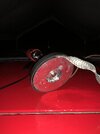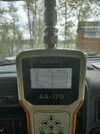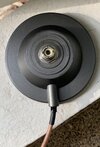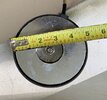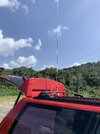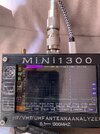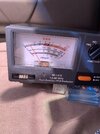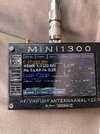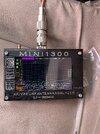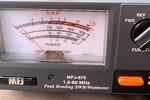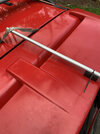Brandon , I try to answer in order:
1- I attached the ground strap inside the magnet mount, where the shield is attached. I didn’t peel the foil off. ( see picture )
2- I put my antenna on the rear of the roof because in theory it makes my antenna a bit more directional in that location, thus signal should be stronger towards the front. I always taught, antennas located on the rear, making them more directional, on a competition, may have a little advantage over antennas on the center. Otherwise, the center is the best location. Why you say the center would be best on a competition if antennas located on the rear have more directivity ? Please, if I am enlighten me regarding this.
3- Yes, I am willing to make changes. Again, why do I have to move the antenna to the center in order to have a chance in a competition? Why you say “ that coax MacGyver style “ ?
It is easy to disassemble the magnetic mount. When you say: “ short the antenna mounting stud to ground” , do you mean to short the center conductor to the shield ? That is easy. I can do it. All I have to do is to loosen the center nut of the magnet, the magnet will drop and can see the coaxial cable attached to the SO-239.
On the Mini 1300 analizer, how do I measure this impedance? Any specific symbol ?
I can follow the other steps you mentioned. And yes, I am still on board with the process .
1- I attached the ground strap inside the magnet mount, where the shield is attached. I didn’t peel the foil off. ( see picture )
2- I put my antenna on the rear of the roof because in theory it makes my antenna a bit more directional in that location, thus signal should be stronger towards the front. I always taught, antennas located on the rear, making them more directional, on a competition, may have a little advantage over antennas on the center. Otherwise, the center is the best location. Why you say the center would be best on a competition if antennas located on the rear have more directivity ? Please, if I am enlighten me regarding this.
3- Yes, I am willing to make changes. Again, why do I have to move the antenna to the center in order to have a chance in a competition? Why you say “ that coax MacGyver style “ ?
It is easy to disassemble the magnetic mount. When you say: “ short the antenna mounting stud to ground” , do you mean to short the center conductor to the shield ? That is easy. I can do it. All I have to do is to loosen the center nut of the magnet, the magnet will drop and can see the coaxial cable attached to the SO-239.
On the Mini 1300 analizer, how do I measure this impedance? Any specific symbol ?
I can follow the other steps you mentioned. And yes, I am still on board with the process .
Attachments
Last edited:

